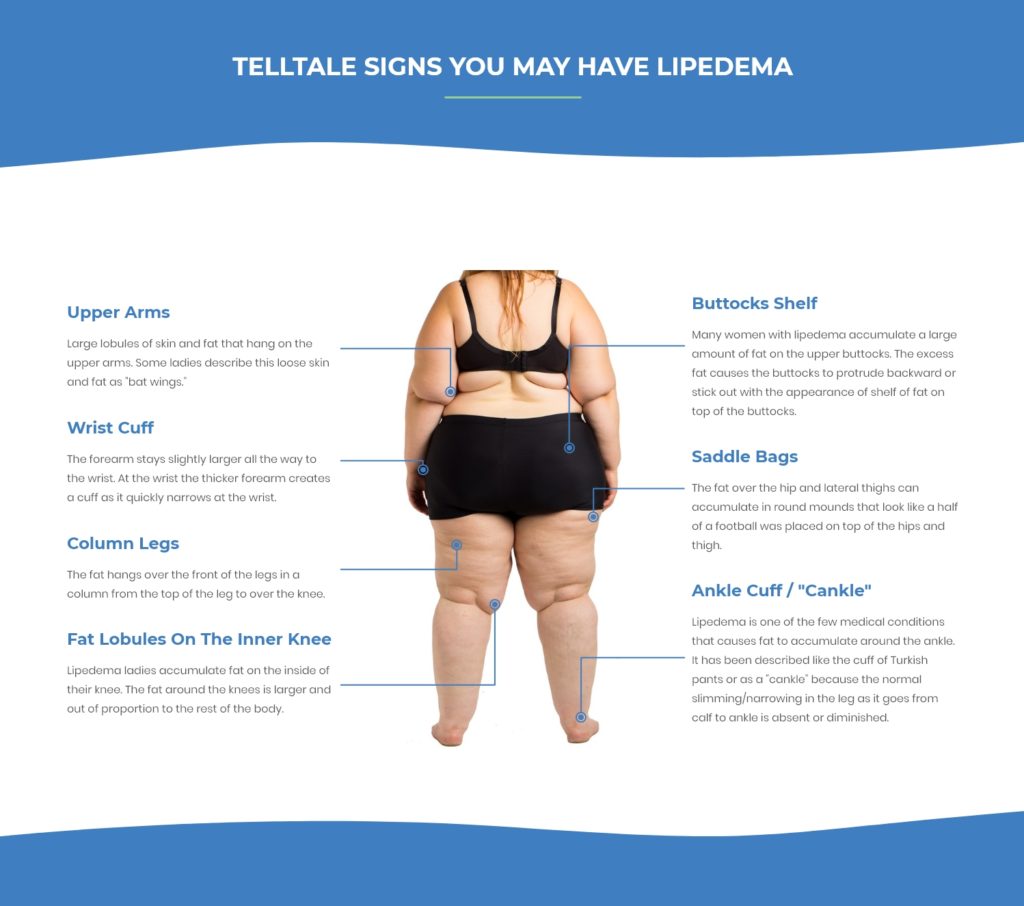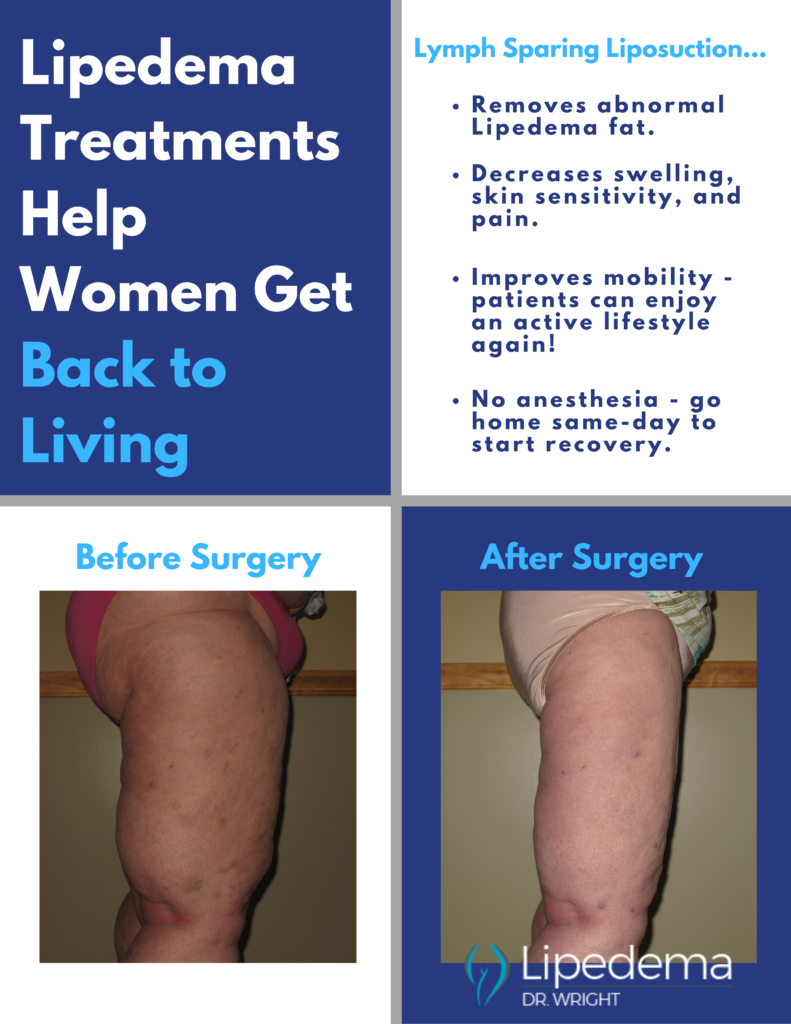When it comes to Lipedema Insurance Coverage and reimbursements, there truly is no black-and-white procedure or practice for getting the healthcare you need and deserve. It’s common for patients to assume their health insurance provider will fulfill their obligation to cover important claims, especially when dealing with vital or preventative healthcare treatments. But sadly, this reality becomes a nightmare for many women seeking life-changing treatment for their lifetime suffering from Lipedema.
Lipedema is a subcutaneous fat disorder that primarily affects the extremities (legs, arms). Its progression is influenced by hormones, and it often affects lymphatic circulation. It was first identified in 1940 by Vascular Doctors Edgar Allen and Edgar Hines at the Mayo Clinic in Rochester, Minnesota. Unfortunately, awareness of the disease is more well known in Europe, and physicians and the general population in the United States are still widely unfamiliar with it, despite it affecting an estimated 10% of women across the globe.
Today, awareness in the US is slowly increasing and a new appreciation of the importance of early diagnosis and treatment in the US is more widely recognized, which we continue to advocate for. Dr. Wright and other leaders in the diagnosis and treatment of Lipedema have worked diligently and unrelentingly to submit new ICD-10 CM codes to the National Center for Health Statistics (NCHS) to help aid healthcare professionals learn about and more easily recognize and diagnose patients with Lipedema, as well as to provide a specific code for health insurance providers to recognize in insurance claims for this disease. This code is a promising step forward in addressing the lack of awareness and understanding of Lipedema and the women who suffer from it, but there’s still work to be done. While the NCHS is expected to make its decision on the new codes at any time, there are still thousands of patients who find themselves in limbo.


Taking everything that we know and everything that’s still unclear, experts have broken down treatment into both surgical and non-surgical options. However, Lipedema is a progressive disease, and non-surgical options have proven to only slow progression rather than reverse it. Women suffering from Lipedema experience a wide range of painful side effects that impact their daily lives and often lead to more serious health concerns as progression continues.
Examples of these side effects include the development of painful fat deposits on the inner, and upper thighs or arms, easy bruising and extremely sensitive skin that is tender to the touch, swollen and heavy limbs that make mobility difficult or impossible to move around at all, and any are no longer able to sit in chairs for more than an hour and lose the ability to climb stairs or even walk up steep paths. These side effects often lead to obesity, lymphedema, and they may develop more serious diseases such as diabetes, heart disease, high blood pressure, and/or high cholesterol.
Both categories of treatment seek to improve the signs and symptoms of leg volume, pain, swelling, disproportionate limbs, and to prevent infection or further progression. However, because Lipedema is a progressive disorder, non-surgical options will only serve to try and eliminate further progression. Surgery via a specialized type of tumescent liposuction is the only way to remove lipedema fat that’s already developed – diet, exercise, and non-surgical treatment options have proved unsuccessful in removing this irregular fat. Extra care must be taken during surgery to avoid lymphatic damage which may be more likely to occur in patients with lipedema. Yo-yo dieting and obesity have shown to make Lipedema worse – so finding the right treatment as early as possible is imperative.


To the dismay of patients, wearing medical-grade, tight compression garments 24-hours per day, seven days per week, is the key to improve circulation for the lymphatic system, making this a go-to prescription from Lipedema experts. Compression garments come in a variety of strengths and will be prescribed based on the stage and type of affected areas. The tighter the compression, the better.
A healthy and consistent lifestyle of clean eating and low-impact exercise to address obesity will also help with Lipedema. A diet focused on low-carb and low-sugar has proven successful. Low-impact exercise such as walking, water aerobics, yoga, or gymnastics has also reported success. Patients must avoid yo-yo dieting while also permanently losing or, at the very least, maintaining their weight. What works for one patient may not work for another. Diet and exercise recommendations and healthy practices are essential, but ultimately should be based on the individual with the understanding that weight gain is not an option.
Some patients opt-in to Manual Lymph Drainage massage (MLD), a gentle skin massage used to stimulate the circulation of the lymphatic system. While experts have yet to find significant evidence that MLD helps with Lipedema directly, some patients prefer it for its “hands-on” nature to addressing their symptoms.
For patients in the later stages of Lipedema, the pain and disruption to daily life are not permanently addressed with compression garments, diet, and exercise alone. Traditional liposuction that uses general anesthesia, radio frequencies, ultrasound, or lasers are possibly damaging to the lymphatic vessels, and as such are not an option for Lipedema patients, either. However, Lymph-sparing liposuction is safe, using surgical techniques that avoid lymphatic injury, and the use of local tumescent anesthesia reduces the risk of complications. Generally, the most painful areas should be treated first, starting high on the legs and then moving downward in future surgeries.
Lipedema is a disease that provides one challenge after another. First, it’s the challenge of getting diagnosed. Then, it’s the challenge of finding a treatment plan that will work. And most difficult of all, finding a treatment plan that your insurance provider will recognize as a covered procedure. As experts continue to emphasize, lymph-sparing tumescent liposuction has proven time and again to be the most effective treatment to slow the progression of lipedema. However, liposuction has historically been considered a cosmetic procedure in the eyes of health insurance providers.
The general rule of thumb for Lipedema Insurance Coverage claims reimbursements is that any given claim must be deemed “medically necessary”. Lymph Sparing Liposuction is nearly always considered a cosmetic surgical procedure in nature or experimental, meaning this is an elective procedure and not a medical necessity. Of course, as explained above, this is absolutely not the case for women with Lipedema, as lymph sparing liposuction is the only treatment option for dealing with this disease that can reverse progression. However, the combination of the surgery being deemed cosmetic and election plus the general under-education and lack of awareness in the medical community has led to the battle patients and Lipedema surgeons are currently fighting. We must educate and advocate for these surgeries to be covered.
When seeking treatment, women with lipedema are faced with two difficult decisions. First, they have the option to pay out-out-pocket for the necessary surgeries and hope for reimbursement later. For women without access to these types of funds, it’s not an option at all. Otherwise, they must decide to put off treatment until they can get their insurance provider to agree to cover the cost. More often than not, this process can take years, involves educating the insurance company themselves on the medical seriousness of the disease and necessity of treatment, and requires several levels of appeal. Some patients are lucky and find a partner and advocate in their healthcare provider, but even with a team behind them, the journey is long and arduous.


Yes! Women with lipedema may have more resources available to them in this journey than they realize. Most importantly, it’s imperative that patients seek out doctors who are Lipedema experts – not just to ensure their surgeries and treatment plans are safe for their own health, but also to ensure their providers are familiar with the arduous journey of documentation during the diagnosis and treatment process. This will be key for getting claims covered – the devil is in the details when it comes to highlighting the medical necessity of these procedures and lipedema treatments. But in addition to their surgeons, there are both attorneys and health insurance claim advocates who can help you work to get your lipedema surgery covered. As a leader in Lipedema treatment, Dr. Wright can put you in contact with attorneys and advocates who also specialize in health insurance claim assistance for women with Lipedema. Attorneys do charge fees for their service but have an excellent track record. Advocates are often a free service for the patients, and many patients report extremely positive experiences working with them. The good news for women with Lipedema is that you may have more options than you realized – there are people here to help you fight, advocate, and get the health care coverage you deserve.


You also have the option to ask your insurance company if they have a patient advocate who can help insured patients get help with their medical problems. Most larger employers have an HR or insurance company liaison that can work as your advocate for coverage for your lipedema. We always recommend starting this process here, in the hopes that your company or employer can set you up with an advocate from the very beginning. If not, local advocates who are familiar with your state’s medical insurer and their policies are also an option, which may be accessible through Consumer Reports, a respected consumer non-profit organization.
If you experience a denial of a health benefit claim, you often have to make a choice between whether to forego treatment or figure out a way to cover the costs for the lipedema surgery on your own. These attorneys and advocates help you ensure your denials aren’t inconsistent with your coverage. If they are inconsistent, they’ll help you fight to get the coverage you deserve. Nobody should have to decide between a life-changing surgery for their health and emptying their savings accounts, and there are lipedema experts out there who can help you navigate your way through a complex system that seems designed to make it difficult, if not impossible, to obtain coverage or necessary treatment.
Please reach out to our office and Dr. Wright’s team would be happy to refer you to experts depending on where you are out in your Lipedema diagnosis and treatment journey.